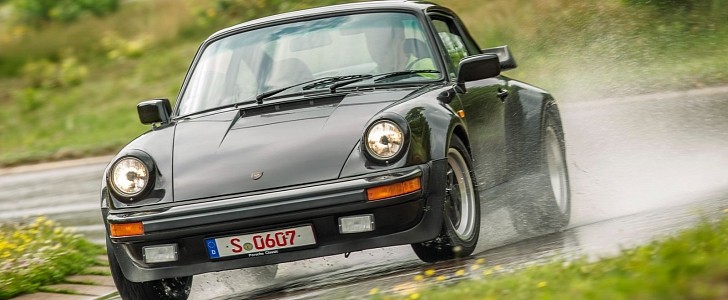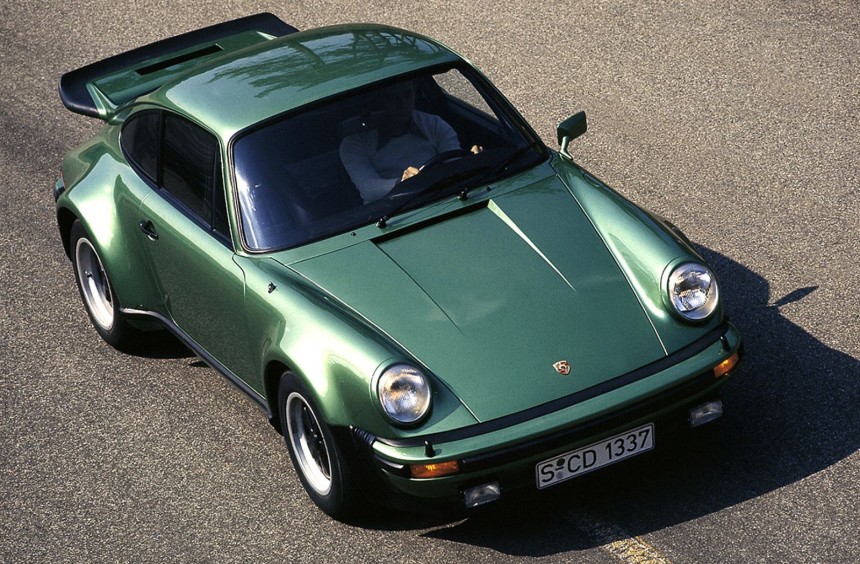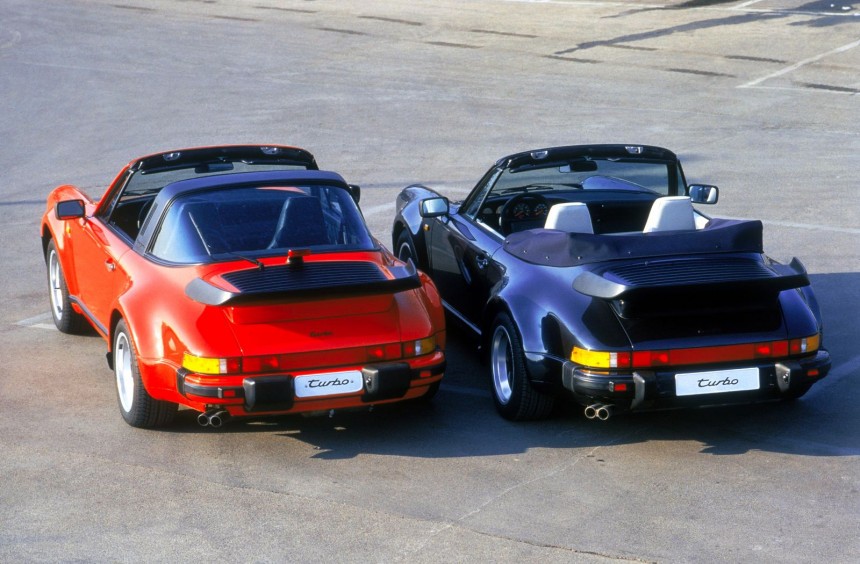The first 911 Turbo was a nearly untamable brute that unapologetically punished inexperienced drivers who didn’t take its raw power seriously. However, those who possessed the right combination of skill, courage, and respect were rewarded with the most exhilarating driving experience of their lifetimes.
Porsche introduced the 911 in the mid-1960s, and although it was a great sports car right from the start, owners and enthusiasts demanded more power. They got their wish in 1967 when the 160-hp 911S was released, but it was still not enough. The German carmaker answered by enlarging the flat-six to 2.2 liters in 1969, them 2.4 liters in 1971, upgrades that boosted the output of the 911S up to 190 hp.
They didn’t stop there, and three years later the first high-performance 911 was born. Named Carrera 2.7 RS, it was lighter than the S and could develop 20 extra horses. The RS got a 3.0-liter with mechanical fuel injection in 1974, a motor that was good enough for 230 hp.
While it was continually developing better naturally aspirated engines, Porsche was also experimenting with turbocharging ever since the 1960s. Initially, efforts were concentrated on race engines, and applying this technology to a mass-produced model was never considered. That changed in the 1970s, when FIA homologation rules required manufacturers to base their turbo weapons on production cars. Therefore, management saw an opportunity to mash two potatoes with one fork by creating a road-worthy turbocharged 911 that could quench the thirst for raw power of its demanding fanbase, and also comply with FIA’s requirements.
Dr. Ernst Fuhrmann, a legendary engineer and the company’s chairman at the time, is credited with the creation of the engine at the heart of this beast. Originally a 3.0-liter taken from the Carrera RS 3.0, Fuhrmann equipped it with a turbo system developed for the 917/30 Can-Am racecar, resulting in 256 hp and 243 lb-ft (329 Nm) of torque.
Linked to a four-speed manual, the powerplant proved to be too much for the standard 911 chassis during initial tests, so the team of engineers widened the rear axle which led to the car’s iconic bulged wheel arches. Furthermore, they developed a new engine cover that featured a big wing designed to create additional downforce, stiffened the suspension, and added bigger brakes. But, as it turns out, these modifications did little to domesticate the beast.
Officially codenamed 930, the 911 Turbo was unveiled at the Frankfurt Motor Show in 1974 and entered production a year later. Much more expensive than a standard 911, yet cheaper than a 3.0 RS, it was the fastest production model Porsche had ever built. With a 0 to 60 mph (97 kph) acceleration time of 5.2 seconds, it was reportedly quicker than a Lamborghini Countach, albeit the Italian supercar could reach a higher top speed.
Wealthy people rushed to buy one, unaware of its true nature. Under 3,000 rpm, it behaved exceptionally well, so drivers were encouraged to floor the gas pedal. Once they did that, the turbo lag gave them a few seconds to pray before propelling their souls into the backseat. Those who weren’t prepared for the sudden burst of power would often lose control and crash. Since this was the 1970s and safety features were virtually nonexistent, many inexperienced owners ended up losing their lives. This earned the 930 a morbid nickname: the Widowmaker.
Despite Porsche’s modifications, the car was prone to oversteer, but those who knew what they were doing and managed to tame it fell in love with its rawness. The carmaker would sell 2,819 of these monsters until 1977 when they decided it was time for an upgrade.
Available as a coupe, convertible, or Targa, it was now equipped with an intercooled, 296-hp boxer that was bored out to 3.3 liters. The 930 also came with a race-derived braking system, new anti-roll bars, stiffer shocks, and larger diameter rear torsion bars. Handling improved and it became less dangerous, but the Turbo still required prudence and respect.
This amazing car was produced until 1989, and it’s estimated that around 18,770 3.3-liter versions were built. Some of them were fitted with a special performance option that unleashed 325 hp. Called Werksleistungssteigerung (Works Performance Increase), this package was only available in Europe for the 1983 model year.
Today, an original 911 Turbo in mint condition is worth well over $150,000. One such example is Deryck Shakespeare’s 1978 3.3-liter, a car that you can learn more about in the video below posted on YouTube by Petrolicious.
It’s hard not to agree that a road-legal car - even a sporty, homologation model - has to be safe and predictable, even when pushed to its limits. However, a petrolhead’s mind works differently, so controlling a raw monster that is out to kill you is the ultimate driving experience. Because it was able to deliver that, the Widowmaker remains one of Porsche’s most iconic models, and one of the purest, most thrilling vehicles ever built.
They didn’t stop there, and three years later the first high-performance 911 was born. Named Carrera 2.7 RS, it was lighter than the S and could develop 20 extra horses. The RS got a 3.0-liter with mechanical fuel injection in 1974, a motor that was good enough for 230 hp.
While it was continually developing better naturally aspirated engines, Porsche was also experimenting with turbocharging ever since the 1960s. Initially, efforts were concentrated on race engines, and applying this technology to a mass-produced model was never considered. That changed in the 1970s, when FIA homologation rules required manufacturers to base their turbo weapons on production cars. Therefore, management saw an opportunity to mash two potatoes with one fork by creating a road-worthy turbocharged 911 that could quench the thirst for raw power of its demanding fanbase, and also comply with FIA’s requirements.
Linked to a four-speed manual, the powerplant proved to be too much for the standard 911 chassis during initial tests, so the team of engineers widened the rear axle which led to the car’s iconic bulged wheel arches. Furthermore, they developed a new engine cover that featured a big wing designed to create additional downforce, stiffened the suspension, and added bigger brakes. But, as it turns out, these modifications did little to domesticate the beast.
Officially codenamed 930, the 911 Turbo was unveiled at the Frankfurt Motor Show in 1974 and entered production a year later. Much more expensive than a standard 911, yet cheaper than a 3.0 RS, it was the fastest production model Porsche had ever built. With a 0 to 60 mph (97 kph) acceleration time of 5.2 seconds, it was reportedly quicker than a Lamborghini Countach, albeit the Italian supercar could reach a higher top speed.
Despite Porsche’s modifications, the car was prone to oversteer, but those who knew what they were doing and managed to tame it fell in love with its rawness. The carmaker would sell 2,819 of these monsters until 1977 when they decided it was time for an upgrade.
Available as a coupe, convertible, or Targa, it was now equipped with an intercooled, 296-hp boxer that was bored out to 3.3 liters. The 930 also came with a race-derived braking system, new anti-roll bars, stiffer shocks, and larger diameter rear torsion bars. Handling improved and it became less dangerous, but the Turbo still required prudence and respect.
Today, an original 911 Turbo in mint condition is worth well over $150,000. One such example is Deryck Shakespeare’s 1978 3.3-liter, a car that you can learn more about in the video below posted on YouTube by Petrolicious.
It’s hard not to agree that a road-legal car - even a sporty, homologation model - has to be safe and predictable, even when pushed to its limits. However, a petrolhead’s mind works differently, so controlling a raw monster that is out to kill you is the ultimate driving experience. Because it was able to deliver that, the Widowmaker remains one of Porsche’s most iconic models, and one of the purest, most thrilling vehicles ever built.



















